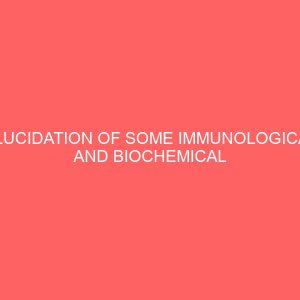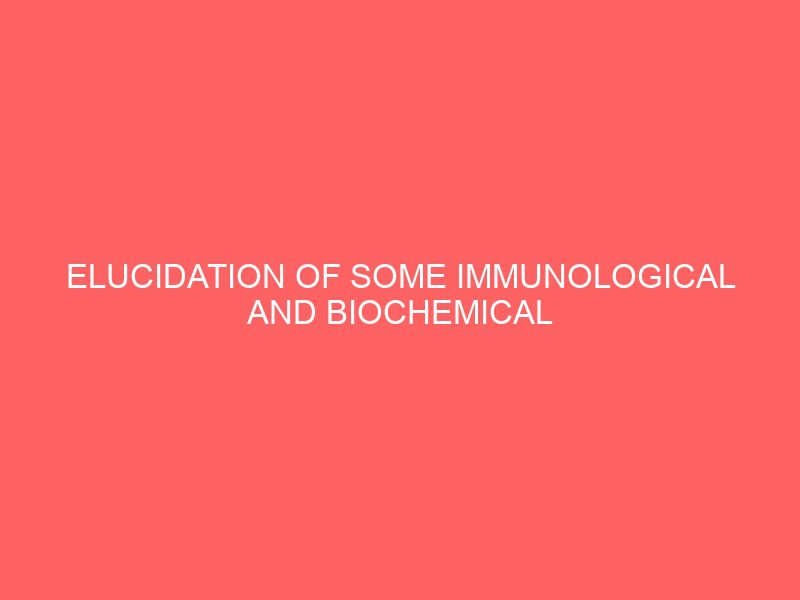Description
CHAPTER ONE
INTRODUCTION
This research is on Elucidation of some immunological and biochemical nature of the leaves of senna mimosoides. Plants are known to contain a variety of secondary metabolites. These secondary metabolites or bioactive compounds have definite physiological effects on the human system. According to Yadav and Agarwala (2011), approximately 25 percent of all prescribed medicines today are substances derived from plants. Interestingly, many phytochemicals have been discovered and even isolated from a variety of medicinal plants. However, many more of them are yet to be exploited for clinical use. Phytochemical analysis of plants is importante due to the need for alternative drugs of plant origin, made imperative by the high cost of synthetic drugs. These secondary plant metabolites extractable by various solvents exhibit varied biochemical and pharmacological actions in animals when ingested (Nwogu et al., 2008).
The use of Senna mimosoides in folklore medicine, precisely in Ukehe, Nsukka, to treat oedema and breastmilk toxicity in neonates was the rationale behind this work. The anti-inflammatory capacity of the leaf extract of Senna mimosoides and its mechanism of action has been reported by Ekwueme et al. (2011a,b).In Nsukka, immediatly after delivery, breastmilk is usually dropped on the leaves of cocoyam or on ants to check its toxicity.Toxic breastmilk usually burns the leaves of the cocoyam or kills any ants it comes in contact with. The prevalence of industries predisposes mothers to chemicals that might accumulate in breast milk. In this study, the immunomodulatory activity and anti-hepatotoxic effect of the leaf extract of S. mimosoideswas investigated because they are the basic mechanism used by the body to prevent or cure diseases. Moreover, the effect of the leaf extract on the activity of lactase,the enzyme that catalyzes the hydrolysis of lactose which is the only carbohydrate present in breast milk was assayed for.
- Overview of the Human Immune System
Immunology is the study of the methods by which the body defends itself against infectious agents and other foreign substances in its environment (Wotherspoon, 2012). There are thousands of components to the immune system and it would appear that the immune system is far more complicated than necessary for achieving what is, on the surface, a simple task of eliminating a pathogenic organism or abnormal ‘self’ cells (Parkin and Cohen, 2001). However there are a number of reasons for this complexity, including the desirability of eliminating pathogens without causing damage to the host. Getting rid of a pathogen or dead host cells is theoretically easy, but eliminating these without damaging the host is much more complicated. As a consequence of this dynamic complexity, the immune system is able to generate a tremendous variety of cells and molecules capable of specifically recognizing and eliminating an apparently limitless variety of foreign invaders, in addition to the recognition and destruction of abnormal cells (Parkin and Cohen, 2001). Once a foreign protein, microorganism (e.g., bacterium, fungus or virus) or abnormal cell is recognized, the immune system enlists the participation of a variety of cells and molecules to mount an appropriate effector response to eliminate or neutralize them (Parkin and Cohen, 2001). Later exposure to the same foreign organism induces a memory response, characterized by a heightened immune reactivity, which serves to eliminate the microbial pathogen, prevent disease and protect against the development of some tumour cells.
1.2The Cells of the Immune System
1.2.1 T Lymphocytes
T-lymphocytes do not produce antibody molecules rather they directly attack foreign antigens such as viruses, fungi, or transplanted tissues (Kruisbeek et al., 2004). One T-cell class carries the CD8 molecule which binds to MHC class I while the other carries the CD4 molecule which binds to MHC class II. T-lymphocytes based on their function are grouped into killer or cytotoxic T-lymphocytes, helper T-lymphocytes, and regulatory T-lymphocytes. T cells displaying CD4+ generally function as TH cells, whereas those displaying CD8+ function as TC cells.Killer, or cytotoxic, T-lymphocytesperform the actual destruction of the invading microorganism (Luckashenaket al., 2008). They do this by migrating to the site of an infection or the transplanted tissues, directly binding to their target and killing it by lysing.
The helper T-lymphocyte and “helps” or enhances the function of B-lymphocytes, causing them to produce quickly more antibodies and to switch from the production of IgM to IgG and IgA and and also assist killer T-lymphocytes in their attack on foreign substances (Parkin and Cohen, 2001). Activation of TH cell makes it an effector cell that secretes various cytokines (O’Keefe et al., 2002) that plays an important role in activating B cells, TC cells, macrophages, and various other T cells, and initiate the delayed type hypersensitivity (DTH) response (Parkin and Cohen, 2001).Regulatory T-lymphocytes suppress or turn off other T-lymphocytes. Without regulatory cells, the immune system would keep working even after an infection had been cured and overreact to the infection (Vignali et al., 2008).
- B-lymphocytes
B-lymphocytes (sometimes called B-cells) are specialized cells of the immune system whose major function is to produce antibodies (also called immunoglobulins or gammaglobulins) (Leen et al., 2013). Antibodies are complex molecules (glycoproteins) that have the property of combining specifically to the antigen that induced its formation. Antibodies are catholic in their recognition; they can recognize free proteins, in solution; proteins displayed on cell walls or membranes; and proteins within higher-order structures, such as viral capsids. When B-lymphocytes are stimulated by antigens, they respond by maturing into plasma cells which are the cells that actually produce the antibodies. These antibodies then find their way into the bloodstream, tissues, respiratory secretions, intestinal secretions, and even tears. The resulting antibodies bind to the invading pathogen, marking it for destruction by killer T-lymphocytes by a process called antibody dependent cell cytotoxicity (ADCC) (Clemenceau, 2008). Antibodies also mark cells for phagocytosis by neutrophils and other phagocytic cells by a process called opsonisation. Most of the daughter cells produced by B cell activation die within a few weeks but a proportion of them recirculate in the body for many years as memory cells. If they are reintroduced to the same antigen that elicited an initial response, they rapidly become reactivated and produce antigen-specific antibody (Leen et al., 2013). There are five distinct classes of antibody, based on the type of heavy chain involved; Immunoglobulin G (IgG); Immunoglobulin A (IgA); Immunoglobulin M (IgM); Immunoglobulin E (IgE); Immunoglobulin D (IgD).
The IgG class is the only class of immunoglobulins which crosses the placenta and passes immunity from the mother to the newborn (Walter and Theil, 2011). Antibodies of the IgA fraction are produced near mucus membranes and find their way into secretions such as tears, bile, saliva, and mucus since it can be transported across, where they protect against infection in the respiratory tract and intestines. Antibodies of the IgM class are the first antibodies formed in response to infection. They are important in protection during the early days of an infection. Antibodies of the IgE class are responsible for allergic reactions. IgE sensitizes specialized ‘mast’ cells, important in protecting a gainst parasitic infections.
1.2.3 Natural killer (NK) Cells
NK cells are large, granular lymphocytes that are capable of lysing or killing infected or tumour cells without overt antigenic stimulation or recognition (recruiting specific immune response) (Parkin and Cohen, 2001). These cells can be considered complementary to cytotoxic T lymphocytes (CTLs). Many viruses attempt to circumvent CTL recognition by preventing the MHC molecule from reaching the cell surface – and here natural killer (NK) cells step into the breach. These cells do not recognize specific foreign antigen, instead being activated by the absence of MHC molecules on a cell’s surface, activated NK cells destroy susceptible target cells by inoculating a protein named perforin into the target cell membrane; perforin molecules assemble in the membrane to form a pore, through which other toxic molecules can flow into the target. NK cells are also prolific producers of the antiviral cytokine interferon g (Kim et al., 2011). At the sites of inflammation, activated macrophages produces IL-12 which stimulate NK cells to produce IFN.
1.2.4 Monocyte and Macrophages
Monocytes which make up 2-8% of the WBCs leave circulation and enter tissue, as macrophages. There are two types of macrophages, one that wander in the tissue spaces and the other that are fixed to vascular endothelium of liver, spleen, lymph node and other tissue (Parkin Cohen, 2001). Macrophages are large leukocytes derived from monocytes that function in phagocytosis, antigen processing and presentation, secretion of cytokines and antibody-dependent cell-mediated cytotoxicity (ADCC). Functions of macrophage include killing of microbes, infected cells, and tumor cells, secretion of immunomodulatory cytokines, antigen processing and presentation to T cells. Macrophages respond to infections as quickly as neutrophils but persist much longer; hence they are dominant effector cells in the later stage of infection.
1.2.5 Antigen-Presenting Cells (APCs)
Specifically, APCs are any cells that can process and present antigenic peptides in association with class II MHC molecules on the surface of antigen-presenting cells or altered self-cells (Accolla and Tosi, 2012).These specialised cells, which include macrophages, B lymphocytes, and dendritic cells, are distinguished by two properties: they express class II MHC molecules on their membrane, and they are able to deliver a co-stimulatory signal that is necessary for TH-cell activation (Kuby, 1997). In the presence of soluble antigen, TH cells primed by dendritic cells can interact with B cells and stimulate antigen-specific antibody production (Girolamo et al., 2008). Dendritic cells are equally important in priming CD8+ or TC cells. Interestingly, dendritic cells can directly induce cytotoxic TC cell proliferation with help from TH cells. Antigen-presenting cells (APC) can also elicit a local rapid reaction or cascade of events that triggers the specific-immune responses.
1.2.6 Phagocytes
Phagocytes are specialized cells of the immune system whose primary function is to ingest and kill microorganisms. There are several different types of phagocytic cells. Polymorphonuclear leukocytes (neutrophils or granulocytes) are found in the bloodstream and can migrate into sites of infection within a matter of minutes. It is this phagocytic cell that increases in number in the bloodstream during infection and is in large part responsible for an elevated white blood cell count during infection. Polymorphs play a major role in controling many infections, travelling rapidly to the affected site, assisting in the recruitment of other immune responses, and engulfing the microbes and other debris (Wang, et al., 2006). It is also the phagocytic cell that leaves the bloodstream and accumulates in the tissues during the first few hours of infection, and is responsible for the formation of “pus” (Dale et al., 2008). Monocytes, another type of phagocytic cell, are also found circulating in the bloodstream.







